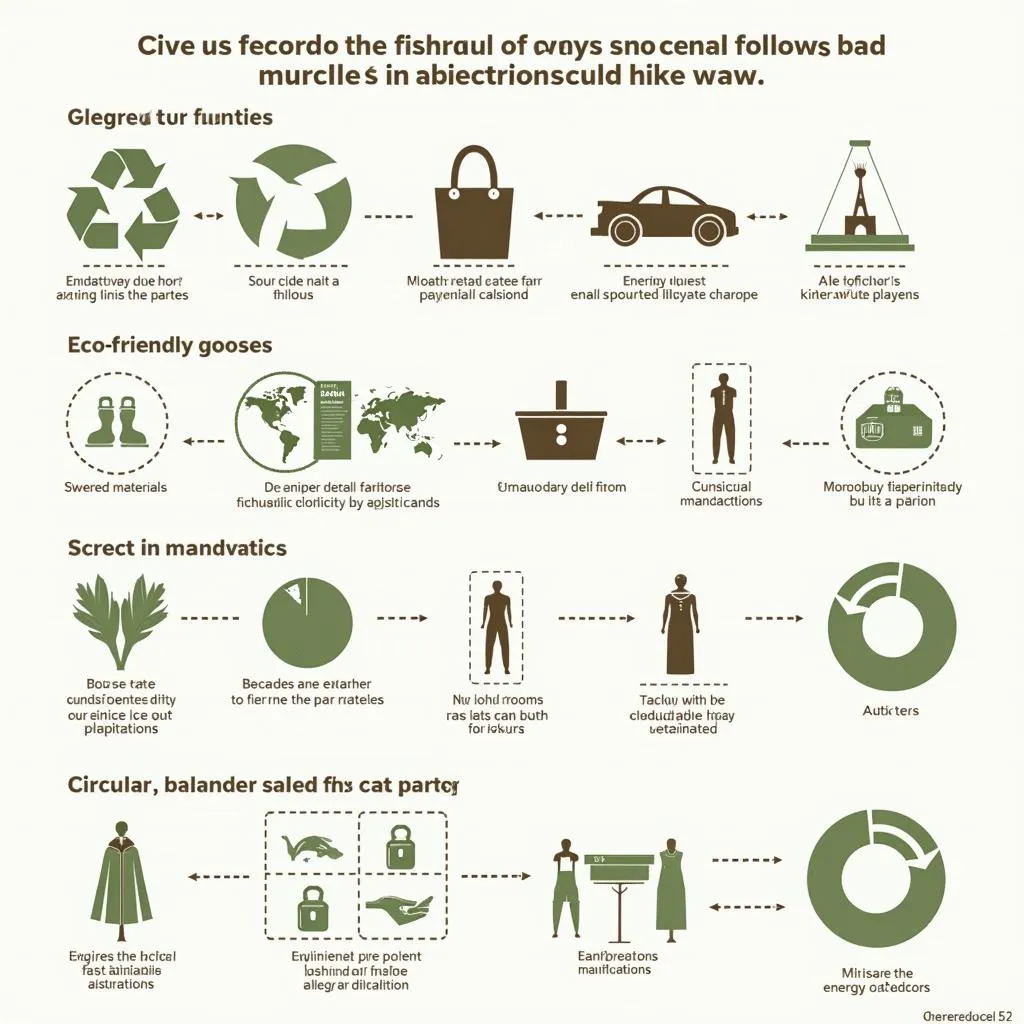The topic of fast fashion brands’ accountability for environmental damage is becoming increasingly prevalent in IELTS Writing Task 2 exams. Based on recent trends and the growing global concern for environmental issues, it’s highly likely that this theme will continue to appear in future tests. Let’s examine a relevant question that has been featured in past IELTS exams:
Some people believe that manufacturers of cheap fashion items should be held responsible for the damage they cause to the environment. To what extent do you agree or disagree?
Analysis of the Question
This question asks for your opinion on whether fast fashion brands should be held accountable for their environmental impact. It’s crucial to:
- Clearly state your position
- Provide reasons and examples to support your view
- Consider potential counterarguments
- Conclude with a summary of your stance
Let’s examine sample essays for different band scores, starting with a high-scoring response.
Sample Essay 1 (Band 8-9)
In recent years, the environmental impact of the fast fashion industry has come under intense scrutiny. While some argue that manufacturers of inexpensive clothing should be held accountable for the ecological damage they cause, I firmly believe that responsibility should be shared among various stakeholders, including consumers and governments.
Undoubtedly, fast fashion companies bear a significant portion of the blame for environmental degradation. Their business model, which prioritizes rapid production and low costs, often leads to unsustainable practices such as excessive water usage, chemical pollution, and textile waste. Moreover, these companies frequently outsource production to countries with lax environmental regulations, exacerbating the problem on a global scale. Therefore, it is reasonable to expect them to take responsibility for their actions and implement more sustainable production methods.
However, it would be overly simplistic to place the entire burden on manufacturers alone. Consumers play a crucial role in driving demand for cheap, disposable fashion. By constantly seeking the latest trends at rock-bottom prices, shoppers inadvertently encourage the very practices that harm the environment. Education and awareness campaigns could help shift consumer behavior towards more sustainable choices, such as buying higher-quality, longer-lasting garments or supporting eco-friendly brands.
Furthermore, governments have a responsibility to enact and enforce stricter environmental regulations. By implementing policies such as carbon taxes, waste reduction targets, and mandatory sustainability reporting, authorities can create a level playing field that encourages all fashion brands to adopt more responsible practices. Additionally, governments can invest in research and development of sustainable textiles and recycling technologies, fostering innovation in the industry.
In conclusion, while fast fashion manufacturers undoubtedly contribute significantly to environmental damage, a holistic approach involving consumers, governments, and the industry itself is necessary to address this complex issue effectively. Only through collaborative efforts and shared responsibility can we hope to mitigate the fashion industry’s ecological footprint and move towards a more sustainable future.
(Word count: 309)
 Fast fashion's impact on the environment
Fast fashion's impact on the environment
Explanation of Band 8-9 Score
This essay demonstrates excellence in several key areas:
-
Task Response: The essay fully addresses all parts of the task, presenting a clear position with a nuanced view of shared responsibility.
-
Coherence and Cohesion: The ideas are logically organized with clear progression. Each paragraph focuses on a specific aspect (manufacturers, consumers, governments) and uses appropriate linking words.
-
Lexical Resource: The essay employs a wide range of vocabulary accurately and effectively. For example, “scrutiny,” “exacerbating,” “disposable fashion,” and “level playing field.”
-
Grammatical Range and Accuracy: It uses a variety of complex structures with minimal errors. For instance, “While some argue that…” and “By implementing policies such as…”
The essay’s sophisticated argument, precise language, and well-developed ideas justify a high band score.
Sample Essay 2 (Band 6-7)
Many people think that companies making cheap clothes should be responsible for harming the environment. I partly agree with this idea, but I also think other groups have a role to play in solving this problem.
On one hand, fast fashion brands do cause a lot of damage to the environment. They make too many clothes too quickly, which uses up a lot of resources and creates pollution. For example, making cotton clothes needs a lot of water, and using chemicals to dye clothes can pollute rivers. These companies should try to use better materials and cleaner ways of making clothes to help the environment.
However, I don’t think it’s fair to blame only the companies. Customers who buy cheap clothes all the time are also part of the problem. If people keep wanting new clothes every week, companies will keep making them, no matter how bad it is for the environment. Maybe if people bought fewer clothes or chose more expensive but longer-lasting items, it would help reduce the damage.
The government also has a job to do. They can make rules to stop companies from polluting too much or using harmful materials. They could also give rewards to companies that use eco-friendly methods or punish those that don’t care about the environment. This would encourage all fashion brands to be more responsible.
In conclusion, while fast fashion companies should take some responsibility for environmental damage, I believe that customers and governments also need to play their part in finding a solution. Only by working together can we really make a difference in protecting the environment from the harmful effects of cheap fashion.
(Word count: 275)
Should fast fashion companies be held accountable for pollution is a complex issue that requires a multifaceted approach, as demonstrated in this essay.
Explanation of Band 6-7 Score
This essay demonstrates good qualities but lacks the sophistication of a higher band score:
-
Task Response: The essay addresses the main parts of the task and presents a clear position. However, the ideas could be more fully developed.
-
Coherence and Cohesion: The essay is generally well-organized, but the use of cohesive devices is less sophisticated than in the Band 8-9 essay.
-
Lexical Resource: The vocabulary is appropriate but less varied and precise compared to the higher band essay. There’s some good use of topic-specific vocabulary like “eco-friendly methods.”
-
Grammatical Range and Accuracy: The essay uses a mix of simple and complex sentences with generally good control, but lacks the variety and sophistication of the Band 8-9 essay.
The clear structure, relevant ideas, and adequate language use place this essay in the Band 6-7 range.
Sample Essay 3 (Band 5-6)
These days, many people talk about how cheap fashion hurts the environment. Some say the companies that make these clothes should be blamed. I think this is partly true, but not completely.
First, it’s true that fashion companies do bad things to nature. They make too many clothes and use lots of water and chemicals. This is not good for the planet. They should try to be better and use less harmful ways to make clothes.
But it’s not only the companies’ fault. People who buy cheap clothes all the time are also part of the problem. If we keep buying new clothes every month, companies will keep making them. Maybe we should buy less and choose better quality clothes that last longer.
Also, I think the government should help. They can make rules to stop companies from hurting the environment too much. They can also teach people about how to buy clothes in a better way for the planet.
In the end, I think everyone needs to work together to solve this problem. Companies, people who buy clothes, and the government all have a job to do. If we all try to do better, we can help save the environment from cheap fashion.
(Word count: 201)
Explanation of Band 5-6 Score
This essay demonstrates several characteristics of a Band 5-6 response:
-
Task Response: The essay addresses the main topic, but the ideas are less developed and the position is less clear compared to higher band essays.
-
Coherence and Cohesion: There’s a basic structure, but paragraphing and linking could be improved. The progression of ideas is sometimes unclear.
-
Lexical Resource: The vocabulary is limited and repetitive, with some attempts at more advanced words (e.g., “harmful”). There are some errors in word choice and formation.
-
Grammatical Range and Accuracy: The essay mainly uses simple sentence structures with limited variety. There are some errors, but they don’t significantly impede communication.
The basic approach to the topic, limited vocabulary, and simple sentence structures place this essay in the Band 5-6 range.
Key Vocabulary to Remember
-
Accountability (noun) – /əˌkaʊn.təˈbɪl.ə.ti/ – The fact of being responsible for what you do and able to give a satisfactory reason for it.
-
Sustainable (adjective) – /səˈsteɪ.nə.bəl/ – Causing little or no damage to the environment and therefore able to continue for a long time.
-
Degradation (noun) – /ˌdeɡ.rəˈdeɪ.ʃən/ – The process in which the beauty or quality of something is destroyed or spoiled.
-
Scrutiny (noun) – /ˈskruː.tɪ.ni/ – The careful and detailed examination of something in order to get information about it.
-
Exacerbate (verb) – /ɪɡˈzæs.ər.beɪt/ – To make something that is already bad even worse.
-
Disposable (adjective) – /dɪˈspəʊ.zə.bəl/ – Made to be used once or for a short time and then thrown away.
-
Mitigation (noun) – /ˌmɪt.ɪˈɡeɪ.ʃən/ – The act of reducing how harmful, unpleasant, or bad something is.
-
Eco-friendly (adjective) – /ˈiː.kəʊ ˌfrend.li/ – Not harmful to the environment.
-
Outsource (verb) – /ˈaʊt.sɔːs/ – To pay another company to do work for your company rather than using your own employees.
-
Carbon tax (noun) – /ˈkɑː.bən tæks/ – A tax on fossil fuels, especially those used by motor vehicles, intended to reduce the emission of carbon dioxide.
 Sustainable fashion practices and innovations
Sustainable fashion practices and innovations
Conclusion
The topic of fast fashion brands’ accountability for environmental damage is likely to remain relevant in IELTS Writing Task 2 exams. As global awareness of environmental issues grows, similar questions may appear, such as:
- Do you think governments should impose stricter regulations on the fashion industry to protect the environment?
- Some people believe that consumers should bear more responsibility for the environmental impact of their clothing choices. To what extent do you agree or disagree?
- Discuss the advantages and disadvantages of implementing a global sustainability standard for the fashion industry.
To prepare effectively, practice writing essays on these topics, focusing on developing clear arguments, using relevant examples, and employing a range of vocabulary and grammatical structures. Remember to analyze your own essays critically, comparing them to the sample essays provided here to identify areas for improvement.
We encourage you to write your own essay on the topic discussed in this article and share it in the comments section below. This practice will help you refine your writing skills and receive valuable feedback from others preparing for the IELTS exam.
How to promote environmental sustainability in the fashion industry is a crucial topic that you may want to explore further to enhance your understanding and essay-writing skills for the IELTS exam.


